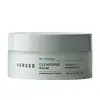What's inside
What's inside
 Key Ingredients
Key Ingredients

 Benefits
Benefits

 Concerns
Concerns

 Ingredients Side-by-side
Ingredients Side-by-side

Ethylhexyl Palmitate
EmollientCaprylic/Capric Triglyceride
MaskingCoco-Caprylate/Caprate
EmollientPolyglyceryl-6 Dicaprate
EmulsifyingSynthetic Wax
AbrasiveTocopherol
AntioxidantTocopheryl Acetate
AntioxidantEucalyptus Globulus Leaf Oil
PerfumingPersea Gratissima Oil
Skin ConditioningEugenia Caryophyllus Leaf Oil
MaskingSimmondsia Chinensis Seed Oil
EmollientPrunus Armeniaca Kernel Oil
MaskingSesamum Indicum Seed Oil
EmollientSclerocarya Birrea Seed Oil
HumectantCaprylyl Glycol
EmollientEugenol
PerfumingLimonene
PerfumingEthylhexyl Palmitate, Caprylic/Capric Triglyceride, Coco-Caprylate/Caprate, Polyglyceryl-6 Dicaprate, Synthetic Wax, Tocopherol, Tocopheryl Acetate, Eucalyptus Globulus Leaf Oil, Persea Gratissima Oil, Eugenia Caryophyllus Leaf Oil, Simmondsia Chinensis Seed Oil, Prunus Armeniaca Kernel Oil, Sesamum Indicum Seed Oil, Sclerocarya Birrea Seed Oil, Caprylyl Glycol, Eugenol, Limonene
Ethylhexyl Palmitate
EmollientHelianthus Annuus Seed Oil
EmollientPEG-20 Glyceryl Triisostearate
EmollientSynthetic Sapphire
Butyrospermum Parkii Butter
Skin ConditioningCaprylyl Glycol
EmollientCocos Nucifera Oil
MaskingTocopheryl Acetate
AntioxidantArgania Spinosa Kernel Oil
EmollientOlea Europaea Fruit Oil
MaskingOryza Sativa Bran Oil
EmollientRosa Canina Fruit Oil
EmollientCitrus Aurantium Bergamia Fruit Oil
MaskingCeramide NP
Skin ConditioningTrihydroxystearin
Skin ConditioningSodium Hyaluronate
HumectantLimonene
PerfumingLinalool
PerfumingEthylhexyl Palmitate, Helianthus Annuus Seed Oil, PEG-20 Glyceryl Triisostearate, Synthetic Sapphire, Butyrospermum Parkii Butter, Caprylyl Glycol, Cocos Nucifera Oil, Tocopheryl Acetate, Argania Spinosa Kernel Oil, Olea Europaea Fruit Oil, Oryza Sativa Bran Oil, Rosa Canina Fruit Oil, Citrus Aurantium Bergamia Fruit Oil, Ceramide NP, Trihydroxystearin, Sodium Hyaluronate, Limonene, Linalool
 Reviews
Reviews

Ingredients Explained
These ingredients are found in both products.
Ingredients higher up in an ingredient list are typically present in a larger amount.
Caprylyl Glycol is a humectant and emollient, meaning it attracts and preserves moisture.
It is a common ingredient in many products, especially those designed to hydrate skin. The primary benefits are retaining moisture, skin softening, and promoting a healthy skin barrier.
Though Caprylyl Glycol is an alcohol derived from fatty acids, it is not the kind that can dry out skin.
This ingredient is also used as a preservative to extend the life of products. It has slight antimicrobial properties.
Learn more about Caprylyl GlycolEthylhexyl Palmitate, also known as octyl palmitate, is created from 2-ethylhexyl alcohol and palmitic acid. It is a fatty acid ester.
The fatty acid content of Ethylhexyl Palmitate makes it an emollient. Emollients help soften and hydrate your skin by trapping moisture within.
Ethylhexyl Palmitate is also used to help improve the texture of cosmetics. It helps other ingredient dissolve in products and help disperse ingredients more evenly.
You'll likely find this ingredient in sunscreen, as it is often used to mix UV-blocking ingredients such as avobenzone and ethylhexyl triazone.
It can also help stabilize the fragrances in a product as a fragrance fixative.
Ethylhexyl Palmitate can be used to substitute mineral oil.
Due to its high fatty acid content, it may not be fungal-acne safe.
Learn more about Ethylhexyl PalmitateLimonene is a fragrance that adds scent and taste to a formulation.
It's found in the peel oil of citrus fruits and other plants such as lavender and eucalyptus. The scent of limonene is generally described as "sweet citrus".
Limonene acts as an antioxidant, meaning it helps neutralize free radicals.
When exposed to air, oxidized limonene may sensitize the skin. Because of this, limonene is often avoided by people with sensitive skin.
The term 'fragrance' is not regulated in many countries. In many cases, it is up to the brand to define this term. For instance, many brands choose to label themselves as "fragrance-free" because they are not using synthetic fragrances. However, their products may still contain ingredients such as essential oils that are considered a fragrance.
Learn more about LimoneneTocopheryl Acetate is AKA Vitamin E. It is an antioxidant and protects your skin from free radicals. Free radicals damage the skin by breaking down collagen.
One study found using Tocopheryl Acetate with Vitamin C decreased the number of sunburned cells.
Tocopheryl Acetate is commonly found in both skincare and dietary supplements.
Learn more about Tocopheryl Acetate